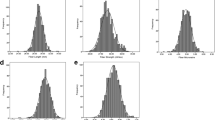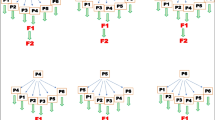Abstract
The usual practice of estimating association and direct and indirect effects among various traits in Gossypium hirsutum is with ungrouped genetic material based on staple length and strength. During 2003–2004 and 2004–2005 genotypic and phenotypic association among ten characters were estimated in G. hirsutum genotypes: (i) set-1: 10 genotypes of low fibre strength (≤196.2 mN/tex) and medium staple length (≤25.0 mm), (ii) set-2: 10 genotypes of high fibre strength (≥235.44 mN/tex) and long staple length (≥28 mm) and (iii) set-3: 20 genotypes of set-1 and 2. The differences in the estimates of associations, direct and indirect effects for different characters in fibre quality groups were examined. The complete analysis of variance for the characters under study viz; days to 50% flowering, plant height (cm), number of monopodial and sympodial branches per plant, seed cotton yield per plant (g), boll weight (g), total number of bolls per plant, lint %, 2.5% span length (mm) and fibre strength (mN/tex) indicated highly significant genotypic differences for genotypes, years and genotype × years interaction. Variation within medium staple length and low strength (set-1), high staple length and high strength genotypes (set-2) and their interaction with year were also significant. Medium staple length and low strength (set-1) versus high staple length and high strength component (set-2) was significant for all the traits indicating significant variability between the sets. A true relationship and direct selection were observed for days to 50% flowering, number of monopodial and sympodial branches per plant with seed cotton yield in the three sets suggesting that separation of genetic material based on staple length and fibre strength for improvement of seed cotton yield through these traits is not required. Magnitude and direction of direct effect and association with yield of the other traits; plant height, number of total bolls per plant, boll weight, lint %, staple length and fibre strength differed between the sets. This study concluded that more successful planning of a breeding programme can be made through path coefficient analysis if the genetic material is grouped based on staple length and fibre strength.
Similar content being viewed by others
References
Altaher AF, Singh RP (2003) Yield component analysis in upland cotton (Gossypium hirsutum L.). J Indian Soc Cotton Improv 28(3):151–157
Amudha K, Raveenderan TS, Krishadows D (1996) Path analysis in coloured linted cotton varieties. Madras Agric J 83:693–696
Dedaniya AD, Pethania KV (1994) Genetic variability, associations and path analysis in desi cotton. Indian J Genet 54:229–234
Dewey DR, Lu KH (1959) A association and path coefficient analysis of components of crested wheat grass seed production. Agron J 51:515–518
Fisher RA, Yates F (1938) Statistical tables for biological, agricultural and medical research, 5 Aufl. Oliver and Boyd, Edinburgh
Gite VK, Misal MB, Kalpande HV (2006) Association and path analysis in cotton (Gossypium hirsutum L.). J Cotton Res Dev 20(1):51–54
Gururajan KN, Sundar S (2004) Yield component analysis in American cotton (Gossypium barbadense L). In: International Symposium on Strategies for Sustainable Cotton Production—A global vision. Crop Improvement, J Indian Soc Cotton Improv 25:1722.325, Nov., University of Agricultural Sciences, Dharwad, Karnataka, pp 201–204
Kaushik SK, Kapoor CJ, Koli NR (2003) Association and path analysis in American cotton (Gossypium hirsutum L.). J Cotton Res Dev 17(1):24–26
Kulkarni VN, Khadi BM, Narayanan K (2003) Development of Gossypium hirsutum L. genotypes with extra long staple cotton and high ginning outturn. J Indian Soc Cotton Improv 28(2):61–69
Ladole MY, Meshram LD (2000) Association and path coefficient analysis in naturally coloured cotton (Gossypium hirsutum L.). J Cotton Res Dev 14:89–92
Manimaran R (1999) Characterisation of cotton genotypes and cultivation of their heterotic potential. M.Sc. (Agri) thesis, T.N.A.U. Coimbatore, India
Meredith WR Jr, Bridge RR (1971) Break up of linkage blocks in cotton Gossypium hirsutum L. Crop Sci 11:965–968
Miller PA, Rawlings JO (1967) Breaking up of initial linkage blocks through intermating in a cotton breeding programme. Crop Sci 7:199–204
Muthu R, Kandasamy G, Jayaramachandran M (2004) Correlation and path-coefficient analysis for yield and fibre quality traits in cotton (G.hirsutum L.). J Indian Soc Cotton Improv 29:17–20
Narayanan SS, Singh P, Singh VV, Chauhan SK (1987) Disruptive selection of genetic improvement of upland cotton. Indian J Agric Sci 57:449–452
Neelma S, Reddy C, Reddy AN (2005) Association and path analysis in American cotton (Gossypium hirsutum L.). J Indian Soc Cotton Improv 30:53–58
Rajarathinam S, Nadarajan N, Sukanya S (1993) Genetic variability and association analysis in upland cotton (Gossypium hirsutum L). J Indian Soc Cotton Improv 18:54–59
Rao GN, Reddy MSS, Shanthi P (2001) Association and path analysis of seed cotton yield and its components in cotton. J Cotton Res Dev 15(1):81–83
Sambamurthy JSV, Rama Rao B (1998) Genetic variability and association analysis in parents and hybrids of American cotton. J Cotton Res Dev 12:236–241
Sambamurthy JSV, Reddy DM, Reddy KHG (1995) Genetic variability, association and path analysis in cotton. J Indian Soc Cotton Improv 20(2):133–137
Singh RK, Chaudhary BD (1985) Biometrical methods in quantitative genetic analysis. Kalayani Publisher, New Delhi
Singh RK, Kakar SN (1977) Control on individual trait means during index selection. Proc Third Cong SABRAO (Canberra), 3rd edn, pp 22–25
Yadav OP, Lather BPS, Dahiya BN (2000) Studies on variability, association and path analysis in American cotton (Gossypium hirsutum L.). J Cotton Res Dev 14:143–146
Author information
Authors and Affiliations
Corresponding author
Electronic supplementary material
Rights and permissions
About this article
Cite this article
Ahuja, S.L., Dhayal, L.S. & Prakash, R. Comparative yield component analysis in Gossypium hirsutum parents using fibre quality grouping. Euphytica 161, 391–399 (2008). https://doi.org/10.1007/s10681-007-9588-y
Received:
Accepted:
Published:
Issue Date:
DOI: https://doi.org/10.1007/s10681-007-9588-y




